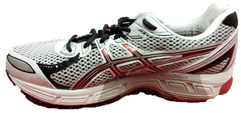 Now, for the blog that everyone really wants to read, let’s talk about running shoes. In part 1 of the blog we thoroughly broke down the human foot and laid the foundation of how to evaluate your foot before buying a shoe. Now we need to look at the different parts of a shoe and how shoes can affect the way your foot functions. Hopefully, this blog will be able to streamline the elements of the shoe that really matter, and show you what aspects of a shoe don’t really matter and are just “Shoe Bling”. I want to thank JAX Outdoors for letting me use their shoes as demos in my community presentations and take pictures of them for this blog. If you have never been to JAX, it’s worth a trip to west Ames to check them out for any of your sporting good needs. When shopping for shoes, you need to have plan for finding the shoe that fits your needs as runner anatomically and functionally (learn more about your foot anatomy and biomechanics in Part 1). For example a runner with a mid-foot strike pattern with a history of ankle sprains that runs daily on cement needs different shoes then a person that only runs on tails, heel strikes, and under pronates. You always need to remember when shopping for shoes, that shoes are tools. Tools help us accomplish tasks more efficiently and help take stress off our bodies; shoes are the same way. But, when all you have is a hammer, and you need a screwdriver, problems will arise. In shoes, the wrong type of shoe can cause injuries and poor fitting shoes will wear out faster too. Shoes can also be used as tools to help change running technique or help protect an injury while it heals. Shoe History: Humans have been walking on two feet for over 5 million years, but the earliest evidence of shoes only carbon dates back 10,000 years. Back then, primitive shoes where were worn to cover and insulate the feet from the elements. Athletic shoes have a very short history, about 100 years ago with development of rubber; companies like Goodyear started producing “sneakers”. It was not until 1970 that Phil Knight and Bill Bowerman began experimenting by pouring liquid rubber onto a waffle iron, that the modern day running shoe was developed. http://www.holabirdsports.com/running-tech-center/running-shoe-history.html Runners typically seem to develop a brand loyalty with shoe companies. Unfortunately this loyalty will get the runner into trouble eventually. Running shoe company's top engineers and executives are like NFL coaches. It seems like every year, half the NFL teams switch coaches and very few coaches now days spend their entire career with one team. The same thing is going on in the running shoe industry. If some new engineer comes up with a new shoe design for company X, Company Y will give the engineer a pay raise to quit and work for them and bring the new knowledge. So when this hot shot engineer takes his new job, he is going to change the design of your favorite shoe from company Y. If the companies are not loyal to you the consumer, you shouldn’t be loyal to them, just find the shoe that fits. Another little corporate secret is that most companies only use about 3 different molds to manufacture all of their shoes. Meaning, you are paying extra money for bright colors and “shoe bling” on shoes that have the exact same midsole and outer as the less expensive models. 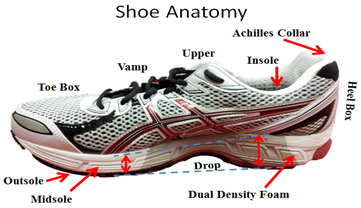 Shoe Anatomy: Starting from the ground up, the part of the shoe that actually contacts the ground is the outsole and is made from a strong dense material. The next layer is the midsole and most of the flexibility and control of foot motion is controlled with in this layer. Typically it is formed from foam, many times different densities and stiffness of foam are used in areas of the shoe where motion of the foot needs to be slowed down. This is called a shoe with dual densities, there may be more than just two types of foam depending how much stability is needed. The layer contacting the foot is the insole, many times this is replaced by an insert or orthotic. An orthotic or athletic insert usually has some type of posting. A posting is anything (foam or plastic) that tries to limit pronation of the foot. Finally, there are the parts of the upper including the heal box, vamp, and toe box. An important measurement that should be addressed in all running shoes is the “drop”. Shoe drop is the delta or change in height from where the forefoot and mid foot are positioned off the ground compared to the rear foot. There are three basic types of shoes. Each one is designed for an ideal category of foot type. As we explained in Part 1, rarely does the shape of the foot (flat, neutral, high arched) match the actual function of the foot (over-pronated, neutral, and under-pronated). But, shoes are still basically broken down into 3 categories matching the 3 foot types: Cushion Shoes, Stability or Neutral Shoes, and Motion control Shoes. I will add four more categories to this discussion, they are: Minimalist, Hybrid, Toe spring, and Trail running shoes. 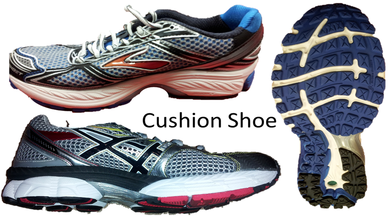 Cushion Shoe: -Purpose is to absorb large amounts of shock while not limiting foot movement. -Designed for the runner who under pronates. -Typically an under-pronator has a stiff foot, so they need a flexible shoe (many times there will be a break in the midsole between the rear foot and forefoot to promote increased shoe flexibility). -Have a curved sole to fit a high arched foot. 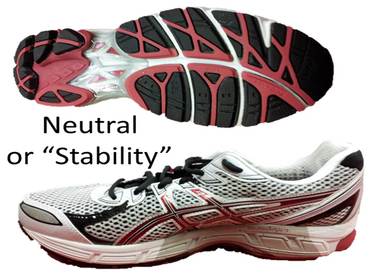 Neutral or Stability Shoe: -Propose to provide shock absorption and basic stability. -Designed for the ideal foot, or a person who wears orthotics. -A semi curved sole with moderate flexibility. -Theoretically, the most purchased running shoe. 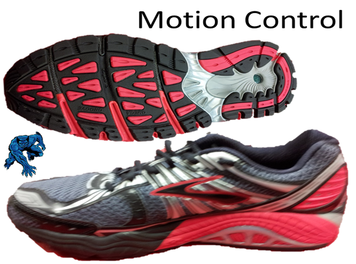 Motion Control Shoe: Propose is to provide maximum stability and support of the foot that over pronates. Very dense, heavy, and thick foam is used in the midsole. The sole is almost straight and there is minimal motion when the shoe is twisted. (It should be noted that in several studies, every classification of runner who ran in motion controlled shoes had increased injury rates compared to other types of running shoe test. Please don’t release the Brooks Beast.)  Minimalist Shoe: The purpose is to mimic barefoot running while still protecting the foot from the elements. Extremely lightweight, minimal to zero drop, maximum flexibility, and a large toe box or individual toe capsules. (You can read more about minimalist shoes in my previous blog) 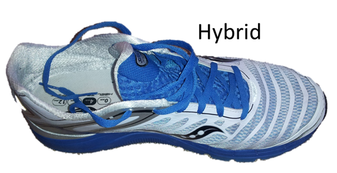 Hybrid: Purpose is to bridge the gap between a cushion shoe and a minimalist shoe. A small drop, and high flexibility, light weight, while still providing some shock absorption. Example: Nike Free  Toe Spring: Purpose is to provide artificial big toe flexion and ankle dorsiflexion for individuals who lack those ranges of motion. A stiff sole with a large arched relief under the forefoot to rock over during gait. 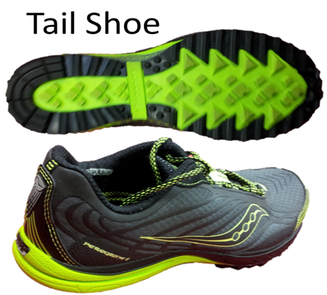 Trail Running shoe: Purpose is to provide a light weight traction shoe that limits ankle sprains. Bottom treads that wick away mud, yet provide superior traction. A low drop with a wide heel to reduce the severity of ankle sprains. Women’s Shoes: There are more than just color differences between male and female shoes. Anatomically and biomechanically, there are significant differences between men and women. Women have shorter legs (as a ratio of total height), wider hips, and more valgus alignment of the knees (“knock knees” or higher “Q” angle). When it comes to shoe fitting they often have more trouble finding shoes that fit well than their male counterparts. Women have triangular and narrower feet compared to males who have more square and wide feet. Their malleoli (ankle bones) are also lower. Women are also more likely to develop foot deformities such as bunions and need to be fit for shoes that provide adequate toe box room. Recommendations for Mid foot and Forefoot Strikers: I recommend a forefoot or mid foot striker wear a shoe with very little drop. Because a high heel/large drop shoe will cause a premature heel strike. This type of runner doesn't need excessive heel cushioning/motion control features, because pronation and shock absorption is basically over when their heel hits the ground. They are often better off with a hybrid or minimalist shoe style. These shoes offer adequate room in the toe box for increased widening of the forefoot on initial contact. If possible a flared heel cuff can be used to add support of the rear of the shoe during contact, taking strain off the Achilles tendon. In the Shoe Store Tips · Weight it: heavy shoes usually provide more shock absorption and/or motion control, but they add weight that must be moved in every stride. · Twist it: does the mid foot flexibility match your foot type needs? · Bend it: does the forefoot bend where your big toe joint is placed within the shoe? · Poke it: are there dual density foams in the right areas for your needs? · Look at it: what is the curve in the sole like? How much of the shoe is “bling”? · Bring the socks you generally wear running to use while trying on the shoes. · Try on shoes later in the day or right after a run so your feet will have swelled. · Shoes should feel great when you put them on, don't buy them thinking you will "wear them in." · If you have wide or narrow feet, look for a brand that has multiple widths to fit your feet. · Find a different shoe if any part of your foot feels like it is rubbing · Do not shop when you are in a hurry. Be sure to walk/run around the store for a few minutes on a hard surface. · NEVER buy “seconds” shoes online, these shoes may save you $20 initially, but in the long term they can cost you much more if you are injured. The reason many shoes are sold at a discount online is that there is a manufacturing flaw within the shoe. Would you by a powertool or a car that had a mechanical defect? (In part 3, the last of the Shoes 101 blog, there will be a discussion about the cause of different running injuries and different shoe strategies to help heel and prevent future injuries)
14 Comments
6/5/2013 10:40:04 pm
This is a great inspiring article. I am pretty much pleased with your good work. You put really helpful information. Keep it up.!!!!!!!
Reply
6/6/2013 11:49:26 pm
Thank you for the comments. I've spent my whole life trying to stay active, but I've been sidelined by a ton of injuries. Any information I've learned along my journey, I'll always try to pass along to others.
Reply
8/30/2013 05:41:56 pm
This is an outstanding post about running shoes. Posts such as this usually are unheard of in the internet.You've added useful, fascinating and also well-written.
Reply
10/5/2013 03:11:30 am
What a commendable work you have done, with simplest of language. I can’t resist myself to leave a comment and trust me it’s hard to impress me.
Reply
10/5/2013 04:57:17 am
I am so happy to read my interesting topic on your web blog.your blog presentation about shoes is marvelous .
Reply
10/7/2013 04:43:12 am
Shoes related all information very awesome.thanks for shearing.
Reply
10/24/2020 07:02:43 am
Your thing with respect to making will be for all intents and purposes nothing hard to come by of amazing. This instructive article is unimaginably valuable and contains offered myself a superior answer for have the option to my own issues.
Reply
1/29/2021 10:45:55 pm
Waw... definitely a deep down informative article. It helped me to choose the best one. Thanks a lot for sharing this article.
Reply
4/5/2021 09:13:47 am
That's interesting that you can add some orthotics t shoes. I could see how that could help them, fit your feet better. Hopefully, that would also help you to perform better in sports.
Reply
2/25/2022 02:03:57 am
Hi! This post couldn't be composed any better! Perusing this post helps me to remember my old flat mate! He generally continued to discuss this.I will advance this page to him. Genuinely certain he will have a decent read.Thank you for sharing!
Reply
2/25/2022 04:54:01 am
I simply needed to tell you all that I added another rundown. It has taken me for some time to tell everybody because of server issues. Everything ought to be in the groove again now.
Reply
2/25/2022 11:45:24 am
For latest news you need to visit internet and on internet I observed this site as a best site for latest updates.
Reply
4/1/2022 01:31:42 am
I very much appreciate it. Thank you for this excellent article. Keep posting!
Reply
1/30/2023 10:51:33 pm
For elderly people the quality of sneakers is so important
Reply
Leave a Reply. |
AuthorDr. Chris Feil Archives
February 2024
Categories
All
|
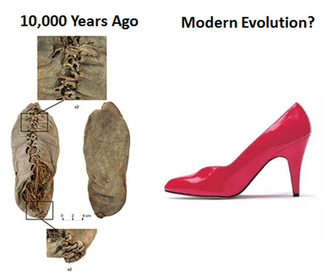
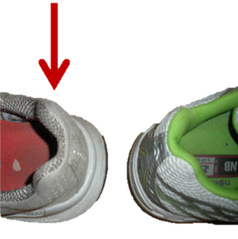
 RSS Feed
RSS Feed